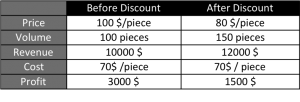Piled up requests in the mailbox reminded me that it’s the end of the fiscal year. Every marketer in the team knows what this means: sleepless nights to prepare for special promotions.
The promotional leaflet always looks fresh, carefully designed following the latest color trend and layout pattern. It will then go through several feedback sessions to change fonts, shades and copies. However, the red percentage number, discount price, seems to be neglected by everyone. “Shouldn’t it be 30% as usual?” Here we send out the year-end promotion, with every detail polished, expect for the discount price, which was decided within 20 seconds based on the “as usual” norm.
The upper part describes how NOT to design the promotional leaflet. You might laugh, but it will astonish you how often promotions are carried out in this manner.
Price is the most powerful and neglected weapon of marketers. We use it every day but rarely give it enough thought that it deserves. Discussing price is difficult. Everyone has some sense of design aesthetics. Most marketers can generate ideas to drive sales volume. A great part of us has the intuition to reduce cost and increase efficiency. However, very little can say what will happen if the price is increased even by 2%.
Although it’s difficult, the discount price by no means should be taken lightly. Done wrong, it can dangerously sabotage your business. To decide the discount price, we need to consider the following 4 questions.
1. Is your product sensitive to discount?
In other words, if you reduce the price by 10%, how many more sales do you think you can make? What about 30% or 50%? Not every product is sensitive to discount. The high price is often regarded as prestige and high quality. If your product is new to the market, and quality is considered very important by your clients, discounting the price might suggest poor quality and attribute your product to the lower end of the market.
2. Are you getting new customers or borrowing customers from yesterday/tomorrow?
When you discount, there are two unhealthy states you want to avoid: borrowing customers from yesterday and borrowing customers from tomorrow.
By borrowing customer from yesterday, I mean when customers get used to your seasonal discount, they will stop purchasing normally and only buy during promotional seasons.
I live close to a subway station near Seoul, South Korea. Since many young Koreans take the subway to go to downtown, cosmetic shops find their potential clients. As more and more shops opened the competition between fierce. Each time I went down the street, I saw big posters featuring 50% discount or 1+1 events. At first, I would take the chance to visit the shop and purchase one or two products that I didn’t plan to buy. Soon, I figured out the shop was having sales half of the time and It made no sense for me to rush. My behavior changed, I would stop buying things when there is no discount, and only visit a cosmetic shop during its promotions.
By borrowing customer from tomorrow, I mean you make discounts to customers who are going to purchase your products anyway. And since they purchase the product today, they will not purchase them for a long time in the future.
Many companies are measuring the efficiency of promotions wrong. I often see people say “During this promotion, we increased our sales by 40%”. While the number looks good, the reality can be different. It’s not uncommon that after promotions, sales fall because customers use up their inventories. To measure the real efficiency, we need to put the promotion in a larger context and longer period.
I worked with a team that sells civil engineering software to Vietnam market. As the economic status of Vietnam was considered lower in South Korea, our strategy was to enter the market with huge discounts. At first, the outcome was great, we quickly attracted attentions from the construction industry and sold many copies. Just before we were about to put more efforts into it and open a branch office in Hanoi, the sales suddenly stopped. The customers who wanted the software already bought it during promotions, we’ve exhausted the market before even entering it.
When you make discount, the best practice is creating new customers or new sales opportunities. If your promotion is borrowing customers from yesterday or tomorrow, then you might need to reconsider about it.
3. Does discount brings you more profit or more revenue?
One of the most important lessons that I’ve learned in my work is that profit is different from revenue.
Let’s suppose your promotion campaign increased sales revenue by 20%. Should you feel happy? relieved? safe? Absolutely not, you should think “What about the profit?” While revenue is important, the profitability of a campaign shouldn’t be neglected. At last, the ultimate purpose of most companies is making money.
Although promotions can easily increase the revenue, making a profitable discount is harder than you thought.
Let’s break it up in a simplified example. Imagine we are selling a 100$ product, the normal sales volume is 100 pieces. Suppose now we make a discount of 20% and sell 50% more instead. Do we earn more money?
You’d be fooled to give a conclusion quickly because the profitability depends on cost too. If the variable cost is 70$/piece, we are actually losing half of the money.

It is, therefore, important to understand your bottom line to make discount that doesn’t harm your profits.